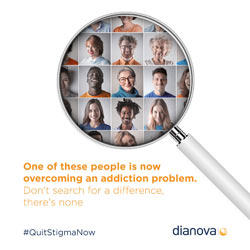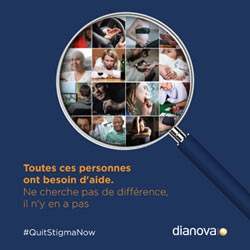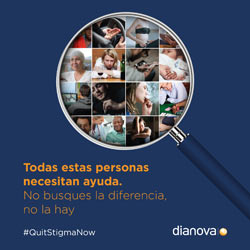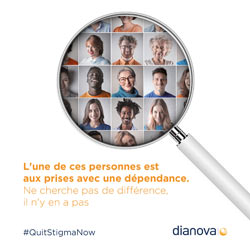Bringing Addiction Stigma to an End #QuitStigmaNow
Starting on 26 June, on the occasion of the International Day against Drug Abuse and Illicit Trafficking, Dianova launches a campaign to raise awareness about the physical and psychological consequences of stigmatizing people facing substance use disorders or behavioural addictions.
The campaign aims to emphasize that addiction is not a personal choice but a public health issue that needs to be addressed as such. Nevertheless many people with substance-related disorders experience social isolation and must face stigma and discrimination. Stigma can have multiple impacts:
- Addiction stigma can affect people in the workplace, it can affect their housing opportunities, social relations and mental and physical health.
- Stigma can result in people delaying their decision to entre treatment, and can hinder access to regular or specific healthcare.
- Stigma can trigger dangerous behaviours.
- Stigma can further compound social disadvantages associated with substance abuse and it can trigger further use of alcohol and other drugs.
Hundreds of thousands of people are criminalized, given long prison sentences, or, in some countries even sentenced to death for having used illegal drugs. In other countries, carrying drugs for personal use can lead to a large fine or even time in prison and the resulting criminal record prevents access to certain jobs.
The Dianova International network supports the implementation of policies based on public health and human rights. The organization calls for an end to these repressive policies that only serve to marginalize and stigmatize drug users and reduce their access to the services they need.
The campaign and the Sustainable Development Goals
The campaign is part of the 2030 Agenda, a global commitment to 17 Sustainable Development Goals adopted by the 193 members of the UN, which is directed at the three areas of sustainable development: economic, social and environmental.
- Goal 3 -Health and Well-being – iexplicitly includes measures to strengthen prevention and treatment programmes for the abuse of psychoactive substances, including alcohol and narcotic drugs. (Goal 3.5). People encounter difficulties when seeking treatment, harm reduction, and reintegration services due to the stigmas and prejudices associated with substance abuse.
- Goal 5 – Gender Equality – points to a need for drug-related policies to recognize that there are important differences between men and women with substance abuse problems.
- Goal 10 – Reduced inequalities – points out that addiction is a public health problem which should be treated as such. uligne que les addictions sont un problème de santé publique qui doit être reconnu comme tel. Stigmatizing drug users can be a major barrier to treatment.
- Goal 16 – Peace and Justice – aims to reinforce the rule of law and access to Justice for all, which implies to combat all forms of discrimination and stigmatization against people with substance use disorders.
Populations concerned
- Women who use or have used addictive substances. They are subjected to a double stigmatization, both as women and as users or ex-users of addictive substances – a situation that may worsen when they have children.
- People who have recovered from abusing addictive substances. The stigma attached to people with addictive disorders may persist for years after they have recovered.
- People with substance-related disorders – They are seen by society as vice-driven people with low morality who are responsible of their condition. The multifaceted nature of the problem as well as the presence of biopsychosocial factors is still not widely understood.
Strategy
This campaign’s objective is to reduce the stigma attached to people with substance-related disorders and to promote treatment and prevention services that are more respectful of their rights.
Through various images and messages, the target audience is invited to follow a series of recommendations geared toward combating stigma. Likewise, they are encouraged to share this material with third parties through their own channels.
Target Audience
- Health professionals – they may hold negative beliefs about patients with addiction disorders. These patients are often considered unpredictable, unable to follow recommendations, or even violent. Being so branded can hinder their access to treatment services.
- Decision-makers – the negative image of people with substance-related disorder in society leads fewer and less meaningful political initiatives in this area. Moreover, this initiatives are often biased by ideological positions.
- Businesses – rather than considering addiction as a problem to be solved to promote the well-being of employees and therefore their engagement for the company, many employers choose to hunt down “drug addicts”, thus generating intolerance and discrimination.
- Mass media, in certain situations, mass media uses a stigmatizing language to describe people who use drugs. Moreover, by connecting drug use to violence, they encourage discrimination and prejudice.
How can I participate in the campaign?
You may participate in the campaign against addiction stigma through the following actions:
- Supporting the campaign on Twibbon
- Publishing a support message on your Facebook or Twitter accounts.
- Modifying your Twitter background image
- Sending an email to a friend and inviting them to participate in the campaign.
More about his issue: downloadable documents
Resources
Additional information
- Campaign’s briefing (pdf): EN ES FR
- Social media kit (pdf): EN ES
- Press release
- Testimonial: “We are people, period”
- Article: Stigma could be the largest contributor to drug-related mortality rates
- Interview with Montse Rafel: “Addiction is not a personal choice!”
- Article: The consequences of addiction stigma











